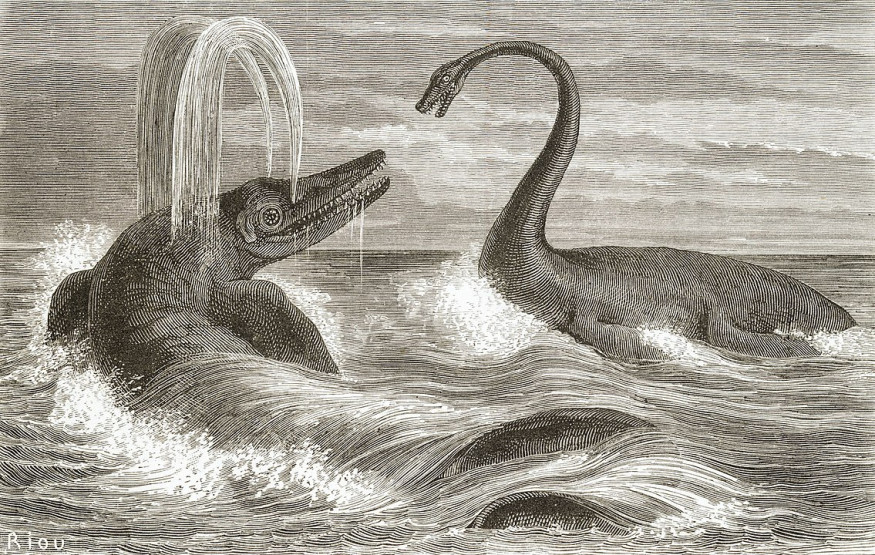Plesiosaur fossils discovered in the Sahara imply that they were not exclusively aquatic creatures. Small plesiosaur fossils, long-necked marine reptiles from the dinosaur era, were found in the Sahara Desert of Morocco, a 100 million year old river system. This finding shows that some plesiosaur species may have resided in freshwater, previously believed to be marine creatures.

Ancient Reptiles
Plesiosaurs were ancient reptiles with small heads, long necks, and four long flippers. Mary Anning, a fossil researcher, discovered them for the first time in 1823. Plesiosaurs were supposed to be aquatic animals, unlike the Loch Ness Monster, and they served as the inspiration for reconstructions of that creature.
Now, researchers from the Universities of Bath and Portsmouth in the United Kingdom and Université Hassan II in Morocco have reported finding tiny plesiosaurs in an African river that dates back to the Cretaceous period.
Discussing the Fossils
The fossils include arm bones from 1.5-meter-long babies as well as teeth and bones from adults who were three meters in length. They imply that these animals regularly inhabited freshwater habitats and subsisted there, sharing them with frogs, crocodiles, turtles, fish, and the enormous aquatic dinosaur Spinosaurus.
The plesiosaurs may have even spent their whole lives in freshwater, like modern river dolphins, according to these fossils indicate they were designed to dwell there.
Georgina Bunker, a student at the University of Bath, Nick Longrich from the Milner Center for Evolution at the University of Bath, David Martill, Roy Smith, and Samir Zouhri from the University of Hassan II served as the paper's lead authors.
The fossils include arm bones from immature juveniles, shed teeth, and vertebrae from the neck, back, and tail.
Since isolated bones are so much more prevalent than skeletons, they provide researchers with more information to work with. "It's scrappy material, but isolated bones tell us a lot about ancient ecosystems and the creatures in them," said Dr. Nick Longrich, corresponding author of the report.
We have over a dozen distinct species in this collection since the bones and teeth were discovered in various places and not all together as a skeleton.
Posthumous Study
The location of an animal's death can be determined by its bones, but its living area may be determined by its teeth because they were lost while the animal was still alive.
Additionally, the teeth exhibit severe wear, similar to the fish-eating dinosaur Spinosaurus discovered in the same beds.
According to experts, this suggests that the plesiosaurs were consuming the same diet, biting down on the armored fish that dwelt in the river. This suggests they were frequent river users rather than passing through.
Plesiosaurs' Living Condition
The abundance of plesiosaur fossils in the river suggests that it's improbable, although aquatic creatures like whales and dolphins often go up rivers for food or because they're lost.
The ability of the plesiosaurs to endure both fresh and salt water, like some whales, such as the beluga whale, is a more feasible hypothesis.
It's also conceivable that, like contemporary river dolphins, the plesiosaurs lived in the river permanently. Due to their small size, plesiosaurs could have hunted in shallow rivers, and the fossils reveal an extraordinary diversity of fish species.
We don't fully understand why the plesiosaurs exist in freshwater, according to Dr. Longrich.
Although it's a little debatable, who's to say that because we paleontologists have referred to them as marine reptiles,' they had to dwell in the sea? Many marine lineages migrated into freshwater.
A type of freshwater seal lives in Lake Baikal in Siberia; freshwater dolphins developed at least four times-in the Ganges, Yangtze, and the Amazon; it's probable that plesiosaurs also adapted to freshwater.
A Diverse Species
The plesiosaurs were frequently discovered in brackish or freshwater in other parts of England, Africa, and Australia. They are members of the family Leptocleididae. Additionally, additional plesiosaurs, such as the long-necked elasmosaurs, have been discovered in fresh or brackish seas in China and North America.
There were plesiosaurs for more than 100 million years, and they were a diversified and versatile group. The authors speculate that they may have frequently infiltrated freshwater to various degrees based on what they have discovered in Africa and what other scientists have found elsewhere.
"How can paleontologists know anything certain about the lives of animals that went extinct millions of years ago? The truth is, we can't always. All we can do is make educated guesses based on our information. We'll find more fossils. Maybe they'll confirm those guesses. Maybe not. That's how paleontology works," said the author.
Lead author Georgina Bunker stated, "It's been incredibly intriguing to watch this project's path. A single bone served as the study's starting point as an undergraduate project, but when more plesiosaur fossils were discovered throughout time, a clearer image of the animal steadily emerged.
Latest Findings
The latest finding increases the Cretaceous variety in Morocco. Kem Kem was undoubtedly an extraordinary biodiversity hotspot in the Cretaceous, according to Dr. Samir Zouhri: "This is another fantastic discovery that adds to the many discoveries we have made in the Kem Kem during the previous fifteen years of study in this part of Morocco."
This was hardly a place to go swimming, but what fascinates me is that the old Moroccan river held so many predators, all living beside one another.
What does all of this mean for the Loch Ness Monster, though? It makes sense on a certain level. Plesiosaurs lived in freshwater habitats as well as the sea. However, the fossil record also implies that the final plesiosaurs perished 66 million years ago, around the same time as the dinosaurs, after about 150 million years.
Related Article : Mammals Evolved Rapidly When Dinosaurs Went Extinct
For more prehistoric news, don't forget to follow Nature World News!
© 2025 NatureWorldNews.com All rights reserved. Do not reproduce without permission.

